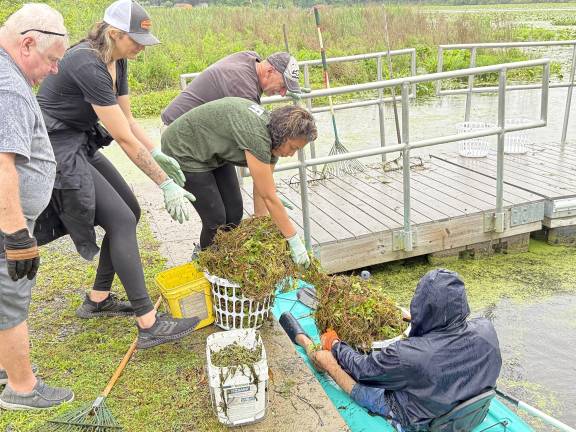Volunteers help remove invasive water chestnuts
Greenwood Lake. Local residents answered the call to help clear the waterway.

Having heard complaints from property owners and visitors about the water chestnuts in Greenwood Lake, Mayor Tom Howley and the Village Trustees put out an “all hands on deck” plea for volunteers to help clear them from Orange County’s largest fresh water lake.
And dozens of an initial group of volunteers answered the call on Saturday, June 7.
Water chestnuts - an invasive aquatic plant with a dense, floating mass - have clogged the shallow areas of lake’s northeast arm, reducing water quality and negatively affecting aquatic ecosystems, recreation, and property values. The plants have voracious appetites for light and resources that outcompete native plants, leading to a decline in biodiversity and a reduction in food and shelter for fish and other aquatic life.
In order to keep them at bay, the village has used a variety of techniques throughout many decades, including aeration, mechanical harvesters, and state and EPA-approved chemicals to inhibit their growth. But just like with gardening on land, one of the best ways to minimize their impact is to get out there and pull the weeds out by their roots.
“Although the rain discouraged some of our residents from coming out today, we are pleased with the progress that we have been able to make so far,” Howley said.
The volunteers established a “bucket brigade” that began with residents using their kayaks and rowboats - equipped with a plastic bucket or two - to fill up. Volunteers were given gloves to protect their hands when uprooting the water chestnuts which can be a little prickly. But they discovered that when the plants are pulled in the right way, the plant root systems gave way fairly easily.
When the containers were filled, the boats returned to shore where they were met by a chain of volunteers (including Trustee Thais Pilieri), who transferred the contents of the containers to a waiting dump truck. After the first couple of hours visitors could see that a channel had already been cleared into the Northeast arm and that more than 50 buckets of water chestnuts had been removed from the lake.
“It’s a painstaking and laborious job, but you can see that we are already making a difference, although a small one, in clearing this part of the lake,” Pilieri said.
According to the N.Y. State Department of Environmental Conservation, water chestnuts are annual plants with hollow, air-filled stems that are 12-15’ long. They have fine roots that anchor the plant to the soil; triangular floating leaves with saw-tooth edges that form a rosette around a central point; tiny, white four-petaled flowers that bloom in June; and seeds that are four-inches long with barbs. Seeds can remain viable for up to 12 years.
Water chestnuts can be controlled using manual, mechanical, and chemical methods, but early detection is key for containing and controlling spread.
The department is funding research on biocontrol - a study of the effectiveness of predator insects from water chestnut’s native range – to help control the spread. The most effective control, however, is to attack the population of plants in the spring before the seeds have a chance to grow.
The DEC recommends harvested plants be placed in black trash bags and left in the sun (before placing into a compost area that is located far away from water sources), or allowed to dry in piles far from water before being incinerated.
Local officials will be dedicating both time and resources to minimizing the continued impact of water chestnuts to the lake as the season continues.
“There is too much at stake for us to stand by and watch the situation get worse,” Howley said. “We are hopeful that more volunteers can join us in future efforts to eradicate this condition.”
Residents interested in joining the effort can leave a message for Howley at (845) 903-2967. He and the Village Trustees are grateful to the number of residents who contributed their time, boats, and efforts during the first of many upcoming days to address the need to preserve the quality of the waterway.